B英语教学设计及教学反思
- 格式:doc
- 大小:20.00 KB
- 文档页数:3

TEACHING OBJECTIVESKnowledge goals 1. Keep the new words, such as celebration, balloon, paper cutting, scissors, lively, historical, heat, polish and complete2. Know about the materials, the procedures and the symbols of the three kinds of art forms.Ability goals 1. Get to know the organization of this passage2. Improve the reading skills3. Draw mind maps and retell the passage according mind maps.Affection goals1. Arouse students’ interest in English learning.2. Learn how to find beauty in these traditional Chinese art forms.3. Develop the pride of our own traditional culture and country TEACHING DESIGNTopic Beauty in Common Things Grade Junior ThreeSectionReading in Section B 2b(Experience beauty in Chinese traditional art & greatness ofChinese people and spread Chinese cultures)About the lessonThis unit is talking about what products are made of andwhere they were made. This lesson focuses on reading andwriting. In this lesson, students will learn about three kindsof traditional Chinese art forms: sky lanterns, paper cuttingand Chinese clay art.The passive voice is to be taken up and the reading skills areto be developed including the love of Chinese culture andour country.AnalysisAbout StudentsJunior Three Ss have a good command of some reading strategies such as skimming for gist, scanning specific details, understanding the cohesion. Besides, most learners are very familiar with traditional Chinese art and culture, so this passage is comparatively easy to understand.TEACHING ASPECTSImportant & difficult points 1. Make the learners be able to learn the following useful words and expressions such as: celebration, paper cutting, scissors, historical, polish and complete. They are made of bamboo and covered with paper.2. Continue to learn Passive voice and understand the structure of this passage.3. Draw mind maps and retell the passage according mind maps.Learning strategies ● Cooperative learning ● Communicative learning ● Task-based learning ● Comprehension learning ● Situational learning ● Learning by doingTeaching aids A multi- media computer systemTEACHING PROCEDURESPROCEDURES Ss’ ACTIVITIES TEACHER’SACTIVITIESPURPOSESPre-class warmer Enjoy several pictures and see howthey change.Greet Ss and elicit the materialto be learned by showing thechanges of pictures.A warmer to get Ssinvolved in the topic. Task 1 SkimmingRead the whole passage quickly andfind the main idea of the passage.Task 2 ScanningRead the first paragraph and find outthree common things.Pre-reading ActivitiesTask 3 SkimmingRead the rest three paragraphs and findout three objects of beauty.Help students get the mainidea of the passage by askingand answering questions.Understand thepassage as a whole.Task 4 ScanningFind answers to the questions related to Sky lanterns Ask Ss find out answers from the reading material.Task 5 Making mind mapsSs work in a group of four, read the third paragraph about paper cutting and draw their own mind maps.Help Ss use the contents to create mind maps.While-reading Activities (Beauty Exploration)Task 6 Mind mapRead the fourth paragraph and complete an unfinished mind map. Then retell according to the mind map.Help Ss dealing withinformation through scanning.Get detailedinformation and buildup the formal schema.Besides, give studentsmore chances to worktogether and developteam work spirits.。
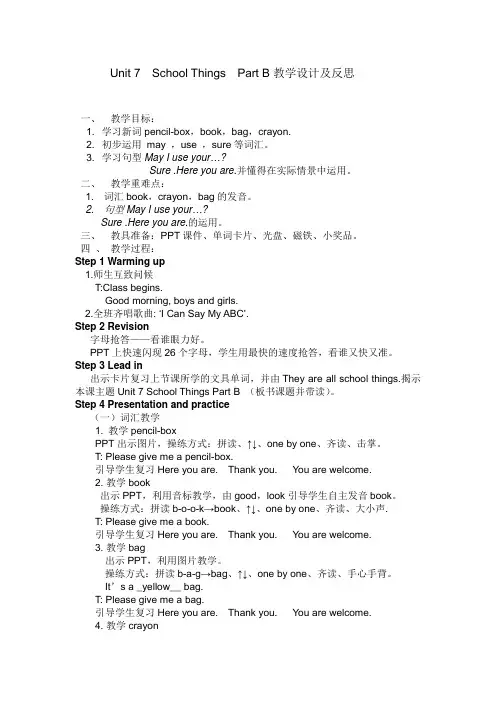
Unit 7 School Things Part B教学设计及反思一、教学目标:1. 学习新词pencil-box,book,bag,crayon.2. 初步运用may ,use ,sure等词汇。
3. 学习句型May I use your…?Sure .Here you are.并懂得在实际情景中运用。
二、教学重难点:1. 词汇book,crayon,bag的发音。
2. 句型May I use your…?Sure .Here you are.的运用。
三、教具准备:PPT课件、单词卡片、光盘、磁铁、小奖品。
四、教学过程:Step 1 Warming up1.师生互致问候T:Class begins.Good morning, boys and girls.2.全班齐唱歌曲: ‘I Can Say My ABC’.Step 2 Revision字母抢答——看谁眼力好。
PPT上快速闪现26个字母,学生用最快的速度抢答,看谁又快又准。
Step 3 Lead in出示卡片复习上节课所学的文具单词,并由They are all school things.揭示本课主题Unit 7 School Things Part B (板书课题并带读)。
Step 4 Presentation and practice(一)词汇教学1. 教学pencil-boxPPT出示图片,操练方式:拼读、↑↓、one by one、齐读、击掌。
T: Please give me a pencil-box.引导学生复习Here you are. Thank you. You are welcome.2. 教学book出示PPT,利用音标教学,由good,look引导学生自主发音book。
操练方式:拼读b-o-o-k→book、↑↓、one by one、齐读、大小声.T: Please give me a book.引导学生复习Here you are. Thank you. You are welcome.3. 教学bag出示PPT,利用图片教学。
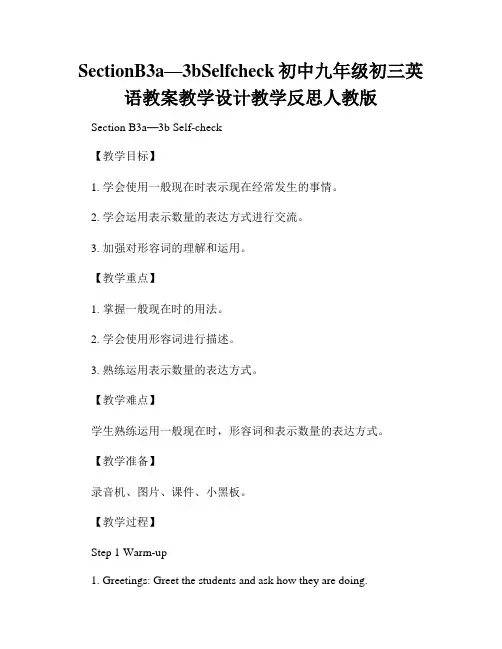
SectionB3a—3bSelfcheck初中九年级初三英语教案教学设计教学反思人教版Section B3a—3b Self-check【教学目标】1. 学会使用一般现在时表示现在经常发生的事情。
2. 学会运用表示数量的表达方式进行交流。
3. 加强对形容词的理解和运用。
【教学重点】1. 掌握一般现在时的用法。
2. 学会使用形容词进行描述。
3. 熟练运用表示数量的表达方式。
【教学难点】学生熟练运用一般现在时,形容词和表示数量的表达方式。
【教学准备】录音机、图片、课件、小黑板。
【教学过程】Step 1 Warm-up1. Greetings: Greet the students and ask how they are doing.2. Review: Review with the students what they learned in the previous class.Step 2 Presentation1. Show pictures: Show some pictures of people doing different activities, such as playing soccer, swimming, and dancing. Ask the students to describe the pictures using the present simple tense. For example, "He plays soccer." "She swims."2. Model sentences: Write the model sentences on the board and ask the students to read them aloud.- He plays soccer.- She swims.- They dance.Step 3 Practice1. Ask questions: Ask the students questions about their daily routines using the present simple tense. For example, "What time do you get up?" "Do you brush your teeth every morning?"2. Group work: Divide the students into small groups and ask them to discuss their daily routines. They should use the present simple tense to ask and answer questions about each other's routines.3. Role-play: Ask a few pairs of students to perform a role-play based on their discussion. One student can act as a reporter and interview their partner about their daily routine.Step 4 Presentation1. Show pictures: Show some pictures of different objects and ask the students to describe them using appropriate adjectives. For example, "The car is red." "The book is interesting."2. Model sentences: Write the model sentences on the board and ask the students to read them aloud.- The car is red.- The book is interesting.- The movie is exciting.Step 5 Practice1. Word association: Show a picture of an object and ask the students to think of an adjective to describe it. For example, if the picture shows a cat, the students can say "cute" or "adorable."2. Pair work: Ask the students to work in pairs and take turns showing pictures to each other. They should describe the pictures using appropriate adjectives.Step 6 Presentation1. Show pictures: Show some pictures of fruits, vegetables, and other food items. Ask the students to describe the pictures using appropriate quantifiers, such as "a bowl of rice," "two apples," "some oranges," etc.2. Model sentences: Write the model sentences on the board and ask the students to read them aloud.- I ate a bowl of rice for lunch.- She bought two apples at the supermarket.- They had some oranges for dessert.Step 7 Practice1. Match game: Prepare flashcards with pictures of different food items and quantifiers. Ask the students to match the pictures with the correct quantifiers.2. Group work: Divide the students into small groups and ask them to make sentences using the food items and quantifiers from the flashcards.【教学反思】本节课主要围绕一般现在时、形容词和表示数量的表达方式展开。

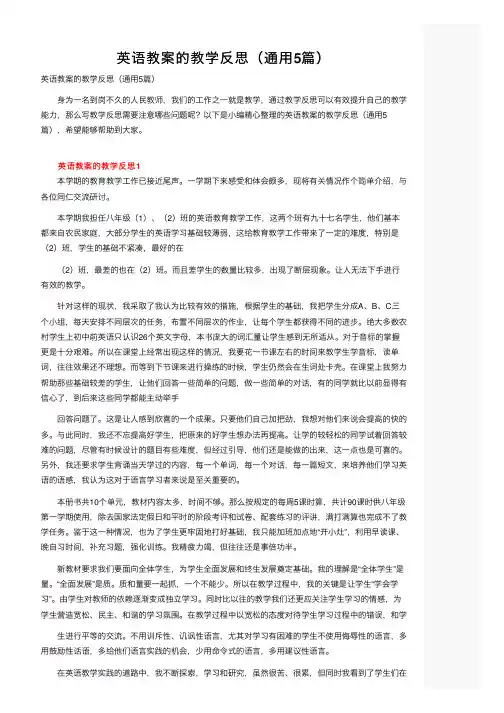
英语教案的教学反思(通⽤5篇)英语教案的教学反思(通⽤5篇) ⾝为⼀名到岗不久的⼈民教师,我们的⼯作之⼀就是教学,通过教学反思可以有效提升⾃⼰的教学能⼒,那么写教学反思需要注意哪些问题呢?以下是⼩编精⼼整理的英语教案的教学反思(通⽤5篇),希望能够帮助到⼤家。
英语教案的教学反思1 本学期的教育教学⼯作已接近尾声。
⼀学期下来感受和体会颇多,现将有关情况作个简单介绍,与各位同仁交流研讨。
本学期我担任⼋年级(1)、(2)班的英语教育教学⼯作,这两个班有九⼗七名学⽣,他们基本都来⾃农民家庭,⼤部分学⽣的英语学习基础较薄弱,这给教育教学⼯作带来了⼀定的难度,特别是(2)班,学⽣的基础不紧凑,最好的在 (2)班,最差的也在(2)班。
⽽且差学⽣的数量⽐较多,出现了断层现象。
让⼈⽆法下⼿进⾏有效的教学。
针对这样的现状,我采取了我认为⽐较有效的措施,根据学⽣的基础,我把学⽣分成A、B、C三个⼩组,每天安排不同层次的任务,布置不同层次的作业,让每个学⽣都获得不同的进步。
绝⼤多数农村学⽣上初中前英语只认识26个英⽂字母,本书庞⼤的词汇量让学⽣感到⽆所适从。
对于⾳标的掌握更是⼗分艰难。
所以在课堂上经常出现这样的情况,我要花⼀节课左右的时间来教学⽣学⾳标,读单词,往往效果还不理想。
⽽等到下节课来进⾏操练的时候,学⽣仍然会在⽣词处卡壳。
在课堂上我努⼒帮助那些基础较差的学⽣,让他们回答⼀些简单的问题,做⼀些简单的对话,有的同学就⽐以前显得有信⼼了,到后来这些同学都能主动举⼿ 回答问题了。
这是让⼈感到欣喜的⼀个成果。
只要他们⾃⼰加把劲,我想对他们来说会提⾼的快的多。
与此同时,我还不忘提⾼好学⽣,把原来的好学⽣想办法再提⾼。
让学的较轻松的同学试着回答较难的问题,尽管有时候设计的题⽬有些难度,但经过引导,他们还是能做的出来,这⼀点也是可喜的。
另外,我还要求学⽣背诵当天学过的内容,每⼀个单词,每⼀个对话,每⼀篇短⽂,来培养他们学习英语的语感,我认为这对于语⾔学习者来说是⾄关重要的。
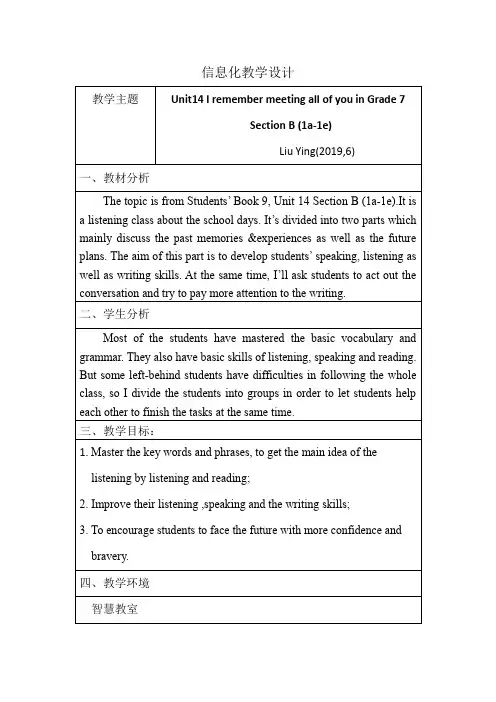

SectionB第三课时(1a~1d)满招损,谦受益。
《尚书》原创不容易,【关注】,不迷路!类别学习重点重点单词knee,sick重点短语gethitonthehead,hurtoneself,haveanosebleed重点句式1.selfinP.E.class.2.Youshouldrunitunderwater.课前预习写一写1.膝;膝盖knee2.生病的;有病的sick 译一译1.击中头部gethitonthehead2.鼻子出血haveanosebleed背一背1.他在体育课上弄伤了他自己。
HehurthimselfinP.E.class.2.你应该把它放在水下冲。
Youshouldrunitunderwater.新课导入Teacanyaccidentss?Ifyoudon’tknowts.1.Whatshouldyoudowhenyouhaveanosebleed?2.Whatshouldyoudowhenyoucutyourself?新课展示【完成教材1a的任务】1.让学生仔细观察1a中的三幅图片,然后根据图片信息回答问题:Whathappenedtothem?2.小组讨论出现1a中的意外情况时,我们应该怎么办?然后将1a中所给出的句子按正确的顺序排序,集体核对答案。
3.两人一组利用1a中的信息编练对话,并邀请几组学生表演对话。
典例参考A:Watterwityback.A:YoushouldgotohospitaltogetanX-rayandrestforafewdays.【完成教材1b~1d的任务】1.学生齐读1b中的句子,为听力练习做好准备。
2.认真听录音,将对话中护士所提到的问题标注出来,集体核对答案。
3.再认真听一遍录音,将相应问题治疗方案的字母写在问题后面,完成1b,集体核对答案。
4.第三遍听录音,并跟读,整体感知对话。
5.利用1b、1c中的信息,仿照1d的形式两人一组来练习对话,并邀请几组学生表演对话。

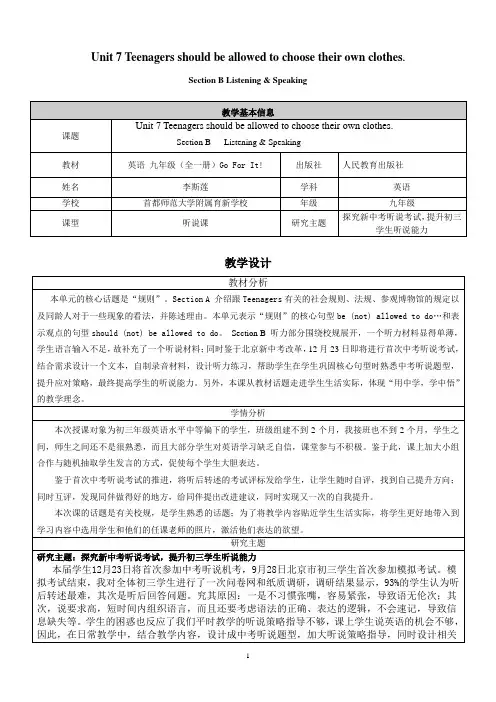
Unit 7 Teenagers should be allowed to choose their own clothes.Section B Listening & Speaking教学设计教学流程Pre-listening While-listening Post-listeningActivity 1:GameActivity 2: 读图预测1st Listening2nd Listening把握大意,捕捉关键信息补充笔记体验语言特点、强化语言结构二选一:You are required to use “be allowed to do/ be (not) allowed to do ”to express the school rule and “should (not) be allowed to do” to express your opinions.Write a short essay about one school rule for students or teacher s:1. What is the rule?2. Do you agree or disagree?3. List at least 3 reasons.3. List at least 3 reasons.Homework激活目标语,引出话题Activity 1:ReadActivity 2:Role play盲听,记笔记听读听力稿转述对话内化,运用目标语言,适当延展While-listening 1st Listening2nd Listening 听填信息预测、记笔记策略指导与运用盲听,速记Post-listening达成教学目标2/3达成教学目标1/2 Read and predict 预测内容、结构3rd Listening听后转述Pre-listeningActivity 3:Role playchant 听完善信息延展对话转述策略与评价指导与运用。
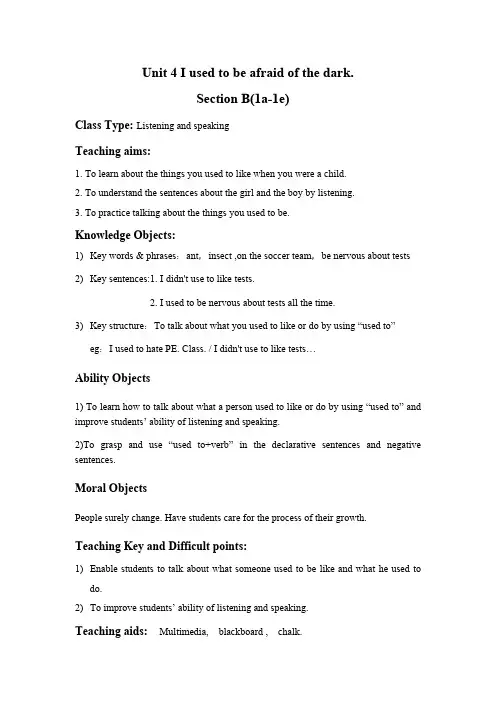
Unit 4 I used to be afraid of the dark.Section B(1a-1e)Class Type:Listening and speakingTeaching aims:1. To learn about the things you used to like when you were a child.2. To understand the sentences about the girl and the boy by listening.3. To practice talking about the things you used to be.Knowledge Objects:1)Key words & phrases:ant,insect ,on the soccer team,be nervous about tests2)Key sentences:1. I didn't use to like tests.2. I used to be nervous about tests all the time.3)Key structure:To talk about what you used to like or do by using “used to”eg:I used to hate PE. Class. / I didn't use to like tests…Ability Objects1) To learn how to talk about what a person used to like or do by using “used to” and improve students’ ability of listening and speaking.2)To grasp and use “used to+verb” in the declarative sentences and negative sentences.Moral ObjectsPeople surely change. Have students care for the process of their growth. Teaching Key and Difficult points:1)Enable students to talk about what someone used to be like and what he used todo.2)To improve students’ ability of listening and speaking.Teaching aids: Multimedia, blackboard , chalk.Teaching Procedures:Step 1 Greeting and Leading in1. Greet the class as usual and Check the homework.2. Watch a short video: See yourself in the mirror3. Show some pictures about their childhoods and let the students to talk about how they have changed using used to and now.Step2 Pre-listening①Look at the pictures about the teacher herself. The teacher asks questions to help students describe the pictures. Use the structure “used to” and now.②Show some pictures and learn the new words like this:T: What did Miss Zhang use to like to do when she was a child?S: She used to like (catching) ants/ (watching) insects.The teaches the new words, Ss read and understand them.③Fill in the blanks and consolidate the new words.Step 3 While-listeningWork on 1c1. Tell Ss to read the sentences in 1c and try to understand the meaning of them.①____ I didn’t use to like tests.②____ We used to walk to school.③____ I used to hate P.E. class.④ ____ I used to be on the soccer team.2. Play the recording for the Ss. Ss just listen for the first time. Then play the recording again and Ss check the sentences they hear in 1c.3. Check the answers. Answers: 1 3Work on 1d1. Ss read the sentences in 1d first.2. Play the recording. Listen and fill in the chart.3. Play the recording again. Ss listen to the recording carefully and try to correct the words.4. Check the answers by asking volunteers to read out the sentences.5.Make a report.Step 4 Post-listening1.Ask Ss to check the things they like /dislike to do when they were children.Ss finish 1a2.Check the answer by asking different Ss to report his work .Work like this.T: What did you use to like to do when you were a child?S:I used to like painting pictures when I was a child.3. T asks “what other things did you use to like to do when you were a child?”.4. Free talk: Ss talk about their changes of their life by using the target language in groups.1) What did you use to be like? What are you like now?2) What did you use to like / hate to do? What about now?3) What was the biggest change in your life? How did it happen?Think about some changes in your life and write down your own sentences.Share your changes with your group members in your own ways.5. Moral Education:Change is necessary as long as you want to be different.Step 3 Homework1.Make more conversations to compare their past with now after class.2.Write a composition to talk about your changes.。
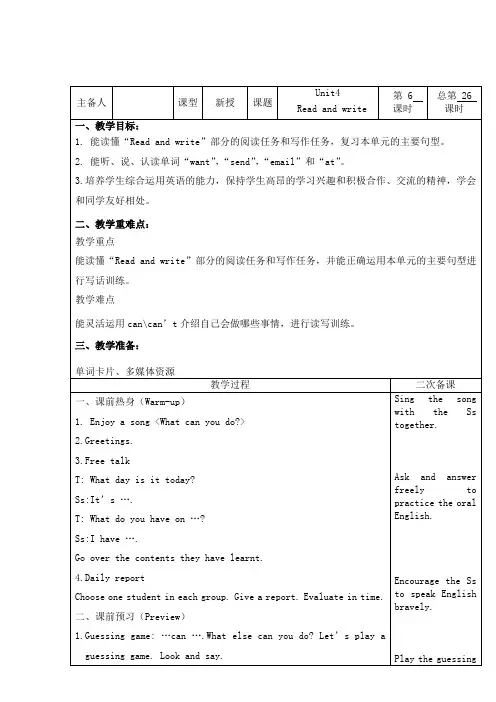
Robin: He can _____ English and Chinese. He can ____ some kung fu. He can ____ ping-pong.Zhang Peng: Can he swim?Robin: No, he _____.Zhang Peng: Oh, who ____ he?Robin: It’s me, Robin.Zhang Peng: Haha!四、巩固延伸(Consolidation & Extension)1. Write and show(练笔秀)Zhang Peng wants to be Robin’s friend. Do you want to be hisfriend? Please write three sentences about yourself. Write them down on the notes. Put them on the blackboard.2. 拓展阅读:五、系统总结What have you learnt this class?Please talk with your partners. 六.Homework: Write and show in class.Read and check the answers.Let the Ss say freely and the teacher completes in time. Read thePEP小学英语五年级上册Unit4 What can you do? B Read and write学情分析五年级的学生们经过了两年的英语学习,已经有了一定的英语知识基础和学习方法的积累,加上社会与家庭的渲染与影响,学生对这英语课程充满了好奇,学生学习热情也比较高。
这也是学生从对英语的无知向求知发展的动力。
这对他们学好英语有很大好处,教师应抓住这一有利因素在教学过程中充分展示这一语言的魅力,让他们一开始就爱上这一学科,激发学生的学生动机。
大班语言教案及教学反思教学内容:认识字母B教学目标:1. 让学生认识字母B的形状和发音。
2. 培养学生对字母B的记忆和识别能力。
教学准备:1. 字母B的大字卡片、小字卡片。
2. 字母B的图片。
3. 指示物品(如球、笔等)。
教学步骤:Step 1 导入:(5分钟)1. 引导学生回顾前几节课学过的字母。
2. 出示一个字母B的大字卡片,让学生猜猜这是什么字母。
Step 2 呈现:(10分钟)1. 出示字母B的大字卡片和小字卡片,分别向学生展示字母B的形状。
指给学生看大字卡片,然后给学生小字卡片让他们仔细观察。
2. 教师大声读出字母B的发音,让学生跟着读几遍。
Step 3 操练:(15分钟)1. 将字母B的图片展示给学生看,教师引导学生说出图片名称,并帮助学生注意每个单词的开头是不是字母B。
2. 教师引导学生用手写出字母B的形状,并让学生模仿跟着写。
3. 教师给每个学生发一张小字卡片,让学生根据图片名称决定是保留卡片还是将其放入盒子中。
4. 教师出示一个指示物品(如球),让学生观察物品的首字母是不是字母B,并做出相应的动作(举起球或放下球)。
Step 4 巩固:(10分钟)1. 出示一系列字母卡片,包括字母B和其他字母,让学生找出字母B并大声念出来。
2. 分发一本简单的绘本,让学生寻找书中有字母B的单词,并大声读出来。
Step 5 练习:(15分钟)1. 将黑板分为两列,左边写字母A,右边留空。
教师用粉笔写“B”,然后让学生跟着写,最后复习字母A。
2. 分发练习册,让学生在册子上完成相关的习题。
Step 6 综合:(10分钟)1. 出示一系列图片,让学生说出图片名称,并注意每个单词的首字母是不是字母B。
2. 教师总结和强化学生对字母B的认识,夸奖学生的参与和表现。
教学反思:本次课是关于字母B的教学,通过多种教学方法培养学生对字母B的记忆和识别能力。
整个教学过程中,学生的积极参与和表现较好,基本达到了预期的教学目标。
Oxford English 2B
Unit 2 In the circus (the third period)
I. Teaching purpose
1. Use imperatives to draw attention to something. Look at ……
2. Use nouns to identify zoo animals.
3. Use adjectives to describe animals. E.g. It’s big and brown.
II. Main points:
Use adjectives to describe animals.
III. Difficult points:
Use adjectives to describe animals.
IV. Teaching materials:
Student’s Book 2B page 8. Courseware 2B unit2
Word and picture card 2B
V. Teaching procedures:
Step1. Warming up
1.Greetings
2.Sing a song “Look at the bear”as warming up.
Step2. Pre-task preparation
1.Show the pictures on the lecture slides for the animals that
taught in the last period. Look at the pictures and revise the
animal words.
2.Show a picture of a circus. Ask students to discuss what they
can see at a circus.
Step 3.while-task procedure
1.Play the animation of the circus for page 8. Invite students to
say aloud the animals in the animation.
2.Say “Look at the bear.’’ Then ask students to answer some
questions about the bear. E.g. Is it big? What color is it? Is it big and brown?
3.Repeat step 2 with the other animals, such as elephant, horse,
monkey, tiger, and panda.
4.Play the courseware again for students to listen to the native
speakers’ pronunciation while looking at the an imation.
Students listen and repeat.
Step4. Post-task activities
1.Divide students into pairs. In pairs they take turns to ask each
other about the animals in the picture. E.g. one says ‘ look at the bear.’ The other says ‘ It’s big and brown.’ Then they change roles.
2.Let a few pairs practice in the front of the class and compete
which pair is the best at presenting.
Step5. Consolidation
Workbook page 5: listen and write the correct number in the box
教学反思:
我讲课的内容是牛津英语2B第二单元第三课时的内容,本节课中,句型look at….... It’s…and….的练习和运用则既是重点,也是难点.为了让学生能较好地把握新词句,我运用多媒体动画课件教学,并采用分层教学的方法,突出了重点(句型学习:模仿——跟读——纠正——巩固——运用),突破了难点(句型与对话:找个别同学读,让同学一排一排的读——二人合作意义操练,教师引导说——半扶半放说——自由说),让学生的学习有据可依、有梯可爬。
本节课虽然在精心的设计下,产生了师生互动,基本完成了教学内容,但还是存在着一些问题:
学生个体差异考虑不周——备课,要备学生。
备课时,我仅根据平时自己的所想,采用高密度、多信息的教学方法,以为用不同形式的活动可以引导学生到达“目的地”——运用新词句自由说。
由于对学生个体差异欠考虑,过高估计了学生的原有认知和综合运用语言的能力,导致了个别学生有些“消化不良”,没能完全接受教学内容。
这个教训进一步提醒了我:首先,在今后备课时,不但要认真备教材,还要充分备学生,为可能出现的变化作好准备;其次,在教学中出现此类情况时,我应当立即降低教学难度,让学生可以在同一目标的不同层次有所发展,不会“因噎废食”。
正是这一次的英语公开课课,使我在如何精心备好课、备学生的问题上懂得了更多,也为我以后的教学起到了很好的警示。
作为一名教师,我会在观察中及时反思,不断发现问题,寻求策略,增进教学效果,同时虚心的向其他优秀的英语老师学习,不断改进自己的教育教学方法,尽快的提高自己的教学水平,从而提高教学质量。